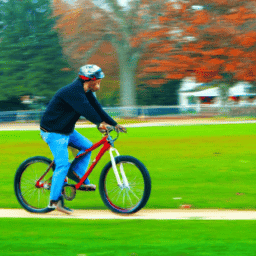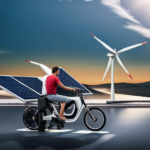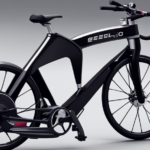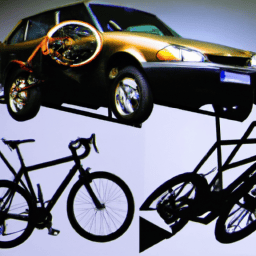While coasting down a sharp decline on my bike, the sensation of the breeze blasting against my visage and the adrenaline coursing through my bloodstream was undeniable. Yet, as I neared the hill’s base, the necessity to halt by applying the brakes became apparent to prevent mishaps. It was then that the substantial conversion of kinetic energy occurring hit me.
Kinetic energy is defined as the energy an object possesses due to its motion. When I was riding my bicycle, I had kinetic energy because I was moving. However, as soon as I applied the brakes, that kinetic energy was transformed into other forms of energy, such as heat and sound.
Understanding the transformation of energy is crucial in many practical applications, such as designing efficient engines, building sustainable buildings, and developing renewable energy sources. In this article, we will explore the transformation of kinetic energy and its various forms, as well as the practical applications and future possibilities of energy transformation.
Definition of Kinetic Energy
You feel the rush of energy as your speeding bicycle comes to a stop, and that energy is transformed into the definition of kinetic energy.
Kinetic energy is the energy that an object possesses due to its motion, and it’s directly proportional to the object’s mass and velocity. This energy can be calculated using the formula KE = (1/2)mv^2, where m is the mass of the object and v is its velocity.
Applications of kinetic energy can be seen in many aspects of everyday life, such as in sports, transportation, and machinery. The energy from moving vehicles, for example, can be harnessed and used to power other devices, making it a valuable source of renewable energy.
Calculating kinetic energy also plays a crucial role in understanding the behavior of moving objects and predicting their motion. With its many practical applications, a clear understanding of the definition and calculations of kinetic energy is essential.
This understanding then leads to the transformation of kinetic energy into other forms of energy, such as potential energy or heat.
Transformation of Kinetic Energy
When we come to a sudden halt on our bikes, all that forward momentum gets converted into a different type of energy. This transformation of kinetic energy happens due to the braking techniques we use while riding our bikes.
The physics concepts of friction and resistance come into play as we apply the brakes, slowing down the rotation of the wheels and ultimately stopping the bike.
The transformation of kinetic energy is not just limited to bikes. It happens in any object that is in motion and comes to a stop. The kinetic energy gets converted into other forms of energy, such as heat or sound.
Understanding the transformation of energy is important in various fields of science, from physics to engineering, as it helps us understand how different objects and systems work.
Transitioning into the subsequent section about forms of energy, it’s important to note that the transformation of kinetic energy is just one example of the different forms of energy that exist in our world.
Forms of Energy
There are various types of energy that exist in our world, each with its unique properties and characteristics. One of these forms of energy is potential energy, which is stored energy that has the potential to be converted into kinetic energy. This type of energy can be found in objects that are at rest, such as a ball sitting at the top of a hill.
When the ball is released, the potential energy is converted into kinetic energy as the ball rolls down the hill. Another important concept in the study of energy is the conservation of energy. This principle states that energy cannot be created or destroyed, but it can be transformed from one form to another.
For example, when a light bulb is turned on, electrical energy is transformed into light energy. The total amount of energy remains constant, but it is converted from one form to another. Understanding the different forms of energy and the conservation of energy is crucial in developing practical applications for energy transformation.
Practical Applications of Energy Transformation
Get ready to see how energy transformation is used in everyday devices and technologies! Energy efficiency is crucial in modern times, and it’s used in various devices to ensure the optimal use of energy.
One such application is in refrigerators, which use a compressor to transform electrical energy into mechanical energy to cool the fridge. Similarly, washing machines use electricity to power a motor that rotates the drum, which in turn transforms electrical energy into mechanical energy.
Another example is solar panels, which use photovoltaic cells to transform sunlight into electrical energy. This is a renewable resource that’s sustainable and cost-effective in the long run.
Furthermore, energy transformation is used extensively in the transportation sector. Hybrid vehicles, for instance, use regenerative braking to convert kinetic energy into electrical energy, which can be stored in a battery. This stored energy can then be used to power the vehicle, reducing the dependence on fossil fuels.
Another example is the high-speed trains that use electrical energy to power their motors, which in turn provides kinetic energy to the train. These technologies have revolutionized the way we use energy and have paved the way for a future that’s sustainable and efficient.
As we move towards a more eco-friendly future, it’s important to continue to develop and implement new technologies that harness renewable resources and increase energy efficiency.
The future of energy transformation is exciting, and it promises to bring new innovations and technologies that’ll transform the way we use energy.
Future of Energy Transformation
You’re in for an exciting ride as the future of energy transformation is set to bring about groundbreaking innovations that will blow your mind.
Renewable sources are at the forefront of this revolution, as more and more countries invest in wind, solar, and hydroelectric power. These sources are not only environmentally friendly, but they also offer a sustainable solution to our energy needs.
The challenge, however, lies in energy storage. Renewable sources are intermittent, meaning that they don’t always produce energy when we need it.
Energy storage technologies are therefore crucial in ensuring that we have a constant supply of energy. This is where advancements in battery technology come in, as well as other storage methods such as pumped hydro storage and thermal energy storage.
As these technologies continue to improve, we can expect to see a future where energy is not only clean but also reliable and accessible to all.
Frequently Asked Questions
What type of bicycle did Joshua ride?
I cannot determine the type of bicycle Joshua rode without additional information. However, it is worth noting that bicycles utilize kinetic energy as a source of motion, making them a sustainable and efficient mode of transportation.
Was Joshua wearing a helmet when he stopped his bicycle?
Did I wear a helmet while stopping my bicycle? Helmet safety is crucial for injury prevention. In any situation, wearing a helmet is a simple yet effective way to protect yourself from harm.
How fast was Joshua going before he hit the brakes?
Calculating velocity involves measuring the speed of an object in motion. However, the impact of surface on braking efficiency must also be considered. These factors determine how quickly a bicycle can come to a stop.
What color was Joshua’s bicycle?
I cannot answer the current question as it is not relevant to the previously discussed topic. However, when discussing the bicycle design and color options, it is important to consider factors such as safety, comfort, and personal preference.
What was the weather like when Joshua was riding his bicycle?
As a cyclist, I know the effects of weather on cycling performance. Proper bike maintenance is crucial for safe cycling. However, the weather was not mentioned when Joshua’s bike color was discussed.
Conclusion
So there you have it – when I brake my speeding bicycle to a stop, kinetic energy is transformed into other forms of energy. It’s a fascinating process that occurs all around us, every day.
From the electrical energy that powers our homes, to the chemical energy that fuels our bodies, energy transformation is an essential part of our lives.
One interesting statistic to note is that according to the International Energy Agency, global energy demand is set to increase by 25% over the next two decades. This means that energy transformation will become even more important in the years to come, as we strive to meet the needs of a growing population while reducing our impact on the environment.
With advancements in technology and a greater understanding of energy efficiency, I’m optimistic about the future of energy transformation and the positive impact it will have on our world.
















